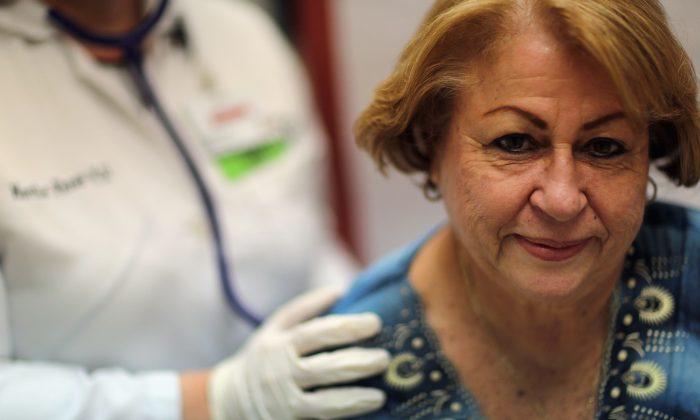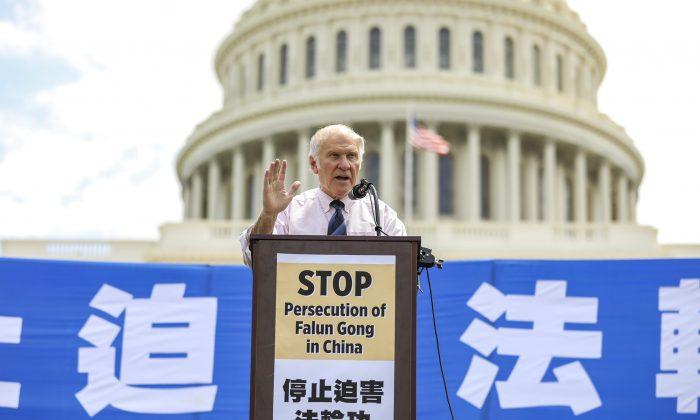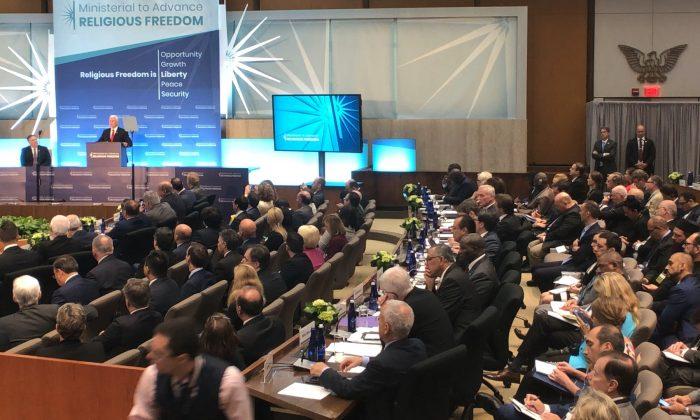WASHINGTON—Only seven weeks remain before the 50 states and the District of Columbia start enrolling individuals and small businesses in health care plans, with coverage beginning as soon as Jan. 1, 2014. States are gearing up for the new enrollees and the many questions that will be asked by the public.
States, either with or without federal assistance have been building up their “exchanges” or health insurer marketplaces. But will the people come? In each state, a small army of people is being assembled and trained to help individuals and businesses choose the plan that is right for them.
The Patient Protection and Affordable Care Act, often shortened to “Obamacare” or the Affordable Care Act (ACA), was signed into law March 23, 2010. It takes effect in stages.
The date that is especially important for the uninsured is Oct. 1, when open enrollment begins for government-subsidized coverage for those who are eligible.
The spotlight for everyone will be on the health care “exchanges,” where individuals and businesses can go to compare policies and prices. Every state will have a health insurance exchange in place by January 2014 that has approved plans. The concept is to provide a one-stop shop for health care coverage.
As the countdown to Oct. 1 marches forward, it would be well to take stock on how state insurance marketplaces are shaping up. To provide an overview of readiness, the Alliance for Health Care and the Commonwealth Fund sponsored a panel of health care experts at the Hart Senate Office Building on Capitol Hill on Aug. 9. Although the briefing was designed for health care professionals, some information provided was useful for understanding what to expect this fall.
Article Continues after the discussion. Vote and comment
[tok id=b7345aa41e3243ff81fbb36c01712b48 partner=1966]
New Enrollment
Seven million people are expected to enroll through health insurance marketplaces in 2014, said Sara Collins, who is with the Commonwealth Fund. Using data from the Congressional Budget Office (CBO), Collins said that this number will rise steadily to 25 million by 2018.
More new enrollees will come through the Medicaid expansion that the ACA permits. Nine million people are expected to enroll in Medicaid/CHIP (Children’s Health Insurance Program) in 2014. That’s set to increase to 12 million in 2015, and hold steady at 12 million through 2018.
Many of these new people will become eligible because of the Medicaid expansion that ACA mandates, although the Supreme Court ruled that states could elect not to participate in that section of the law.
The new Medicaid/CHIP enrollees will be uninsured persons who are above the federal poverty level (fpl) ($14,856 for an individual and $30,656 for a family of four, based on the 2012 federal poverty level). Currently this group is ineligible for Medicaid but those who are below 133 percent of fpl will become eligible for Medicaid under the ACA in 2014.
Beginning in 2014, insurers can no longer deny coverage or charge more because of a pre-existing condition, like asthma or diabetes, or because of gender, under the ACA. The new law also prohibits insurers from enforcing spending caps for essential health care benefits.
Rebecca Pearce, executive director of the Maryland Health Benefit Exchange, was invited to speak about Maryland’s preparations to open its exchange. Maryland was unique. Its governor signed an executive order on the day after the ACA was signed, which authorized a commission to determine how to implement health care reform in Maryland. An exchange was created in 2011. Gov. Martin O’Malley and the Democrat-controlled state Legislature enabled Maryland to develop its own state-run exchange before other states.
Pearce said that Maryland has about 800,000 uninsured and 590,000 who would become eligible under the ACA, either through Medicaid or the exchange. Maryland expects about 250,000 new enrollees in 2014. The number will grow steadily to about 475,000 by 2020, lowering Maryland’s uninsured rate by one-half.
Outreach Critical
“We expect people will want to talk to somebody, not sit at the Internet and fill out [a form], but talk to somebody to really explain things to them,” said Pearce. Maryland will have a call center manned by 125 people.
The law requires the creation of “navigators” to answer questions and guide people through all the complexity of plans and rates.
States view enrollment assistance as critical to maximizing enrollment, said Sarah Dash, Center on Health Insurance Reforms at Georgetown University Health Policy Institute. Thus, “navigators, in-person assisters, certified assistance counselors, and agents/brokers” are being hired and trained, she said.
All states will allow agents and brokers to sell coverage through the exchanges, said Dash.
In Maryland, over 200 navigators, 300 in-person helpers, and outreach workers will work on maximizing the number of individuals and small businesses enrolled, said Pearce. They will primarily be knocking on doors.
Altogether in Maryland, an estimated 5,000 people will support the educating and enrolling effort, including over 2,500 caseworkers who are already determining Medicaid eligibility.
Over 2,000 brokers have already expressed interest in working with Maryland Health Connection, which is where everybody in Maryland will go to enroll on Oct. 1. Over 950 have signed up for training in mid-August, said Pearce.
Preliminary Rate Data
The health plans offered by insurers must fit into four levels of coverage: bronze, silver, gold, and platinum. This standardizes comparing plans and costs. Each plan level must cover the same set of minimum “essential health benefits” that are defined by the law.
All insurers must offer at least one silver plan, and one gold plan. Bronze plans are the cheapest and have less coverage and more out-of-pocket costs, while platinum plans will be the most expensive with the most benefits.
There are also catastrophic plans, which may be most appealing to young people in good health.
The data is very preliminary but the national picture on rates that individuals and businesses will pay is looking very good.
Health and Human Services (HHS) compared individual silver plan premiums proposed for 2014 in 11 states, which have made their information available, with CBO-derived estimates. CBO data was adjusted to make it suitable for 2014 comparisons. Also, rates that will be charged to small employers under ACA were compared in six states where data was available. Rates paid now were estimated into the future.
The findings are that “the lowest cost silver plan in the individual market in 2014 is, on average, 18 percent less expensive than [HHS’s] estimate of 2014 individual market premiums derived from [the CBO],” according to an Office of the Assistant Secretary for Planning and Evaluation (ASPE) research brief.
Small business health coverage is also cheaper, according to the ASPE brief.
The lowest cost silver plan available to employers in 2014 in the six states was on average 18 percent less expensive than premiums small-business employers would pay for the same plan before the ACA.
The ASPE brief concedes that the 11 states may turn out not to be representative of the rest of the nation. But for now, according to the ASPE brief, “greater competition and greater transparency are driving down prices in the marketplace.”
“The number of plans and the rates in our [Maryland] market is going to be competitive,” said Pearce.
Available to Marylanders are 59 medical plans approved by the Maryland insurance commissioner. Maryland offers bronze (12 plans), silver (21 plans), gold (18 plans) and platinum (5 plans), as well as three catastrophic plans.
Rates for health insurance in Maryland will be among the lowest in 12 states that already have approved rates.
The Maryland insurance commissioner had lowered rates by as much as 33 percent below requested rates, said Pearce. She said that a 25-year-old nonsmoker in the Baltimore metropolitan area would pay $167 per month for health insurance, and a 50-year old nonsmoker’s average rate was estimated to be $360.
Variations in State Exchanges/Medicaid Coverage
States have three main ways to handle the new health law.
Sixteen states plus the District of Columbia are pursuing state-run exchanges, such as in Maryland. This category is where the state operates all marketplace activities. These state plans had to be approved by HHS last February.
“Each state electing to establish a new health insurance marketplace must adopt the federal standards in law and rule, and have in effect a state law or regulation that implements these standards,” according to the National Council of State Legislatures.
In the second group, 15 states are pursuing a state–federal partnership exchange.
The third group includes the 19 states that have defaulted to a “federally facilitated marketplace,” where the state chooses not to establish a marketplace. That means Health and Human Services is compelled to establish and operate the health insurance marketplace in that state.
Crosscutting these categories of state involvement in the exchanges is the decision by each state on whether to accept federal support for Medicaid expansion as mandated in the ACA.
Persons, ages 19–64, whose household incomes are equal to or or less than 133 percent of the federal poverty level (fpl), will become eligible for Medicaid under the ACA.
Medicare catches the seniors who are 65 and older.
Choosing to expand Medicaid are 22 states and the District of Columbia. Three states are expanding in unconventional ways, four are unclear or undecided, and 21 states elected not to participate in the Medicaid expansion.





